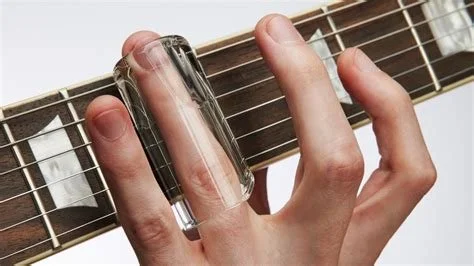The Slide - Usage and Materials
Hello all, Good to be back with you. This time I want to talk about an often heard and often unrecognized tool for guitarists, the slide, or bottleneck, or steel.
If you’ve ever listened to old blues from the American South, you have likely heard the sound of a slide on a guitar. Certainly blues and the slide go together like a redfish sandwich and cajun rice, but the use of a slide spans multiple genres and materials.
Origins
The first slides as we know them were called bottlenecks, literally the necks cut from bottles and then having their edges sanded so as not to cut the player’s fingers. The slide enabled playing the tones between the notes, a commonality in world music and other cultural influences that are not bound by a 12 note system and bypassing the natural limitations brought by fretting a string.
Historians propose that the idea of the slide came from slaves seized from Africa. There is still plenty of atonal music on the continent that supports this idea. Slaves and their progeny brought the slide into the blues with pioneering musicians such as Son House, Bukka White and Robert Johnson made it a hallmark of what we call Delta Blues and those recordings introduced the sound to non-black musicians and listeners. When the movement to Chicago started, musicians such as Muddy Waters brought the slide to electric blues and as we know, many guitar players, particularly in the United Kingdom were heavily influenced by the electric slide players. They then started using the slide in their own music, while some did some pretty obvious lifts from existing delta blues songs.
Playing with a Slide
Typically a slide is worn on the little or ring finger of the left hand and is used to glide along the strings, but not so hard that the slide hits the frets. To prevent this, many slide players set their instruments with higher actions. There are even accessories that ride on the existing nut to raise the action temporarily to prevent fret noise when playing slide. I use one of these on my own resonator guitar that allows me to play single notes without it and slide with it. The tone of slide is often associated with the human voice and as it moves in a portamento brings that forward. Couple this with vibrato and dynamics and you get what what Colin James refers to in his wonderful tune National Steel as “a crying moan”. If you have never heard this song, go to your streaming service and have a listen. It is everything you need to know about the emotional grip of a slide.
It is very common for the guitar to be tuned to an open tuning. Open D, open G and open E are very common choices but so too are chord based tuning such as C6 as we often find in country steel guitar. You can of course play slide in standard tuning but as the string tuning does not naturally create a harmonious tone, it requires greater care and technique to slide only the string or adjacent strings that you want.
Slide Materials
The first slides were made out of glass, coming as they were from bottle necks. A glass slide produces a warm and smooth tone, and synthetic slides can try to achieve the same thing. In my opinion, they don’t although I have a few old ones in my slide collection. I prefer glass to synthetics myself. Duane Allman created a whole mystique when he used a glass Coricidin medicine bottle as a slide and there are today, slides made in the shape of the Coricidin bottle. Does it sound better than other glass? Of course not, but musicians, like many people, can be superstitious and take on beliefs unsupported by facts.
Another option is to make the slide from metal. Steel slides and even steel bars from table style slide instruments are used. The sound is very bright and has long sustain. It sounds like slide but is less subtle and more forward than the sound of a glass slide. Some players, such as Ariel Posen, prefer a brass slide, finding the sound less harsh while retaining the brightness and sustain. Personally I generally prefer the sound of brass over steel, with the exception of when I play a lap steel and then I use a steel bar. You can hear the sound of a lap steel in the music of Larkin Poe.
Yet another option is ceramic material. Billy Gibbons is known for the ceramic slide called the Mud Slide. It’s a nice balance between a glass slide and a metal slide. I have one of those and like it for more Texas style blues while preferring glass for more classic blues and for rock guitar.
We also find slides made from minerals and rocks, as well as slides made from wood. There are lots of options and if you like slide, you’ll need a box to contain all the ones you end up buying. Trust me on this.
This is an image of my own Gretsch Lap Steel. I play it with a “steel” a bar designed for lap steel, but it is definitely slide guitar
Where Can You Hear Slide
I’ve already mentioned the presence of slide in Delta, Chicago and Texas blues, but slide is used much more widely than that. The amazing Bonnie Raitt has played slide since she started and she is known not just for contemporary blues but also for ballads. We can find slide used widely in music from rock bands that were heavily influenced by the blues. Jimmy Page used a fair bit of slide in Led Zeppelin tunes, and the sound of slide is found often in songs by The Tragically Hip. I have already mentioned Larkin Poe as another group using slide tones in their music. Ry Cooder brought the sound of slide to roots and world music. Keith Richards was heavily influenced by the tuning and power of slide that his default tuning is now an open tuning with no low E string at all. Another superb example of slide excellence is Derek Trucks of The Tedeschi Trucks Band. I am not aware of slide in jazz or classical music but that is more to my lack of awareness than an inappropriate use of the tool.
Wrapping Up
The use of slide evokes emotional commotion in many people much more aggressively than playing chords and riffs in standard tuning. This is very true for me, partly because of my strong engagement with old Delta blues and because of the haunting quality of well played slide. It brings a level of depth and dimension you don’t get any other way. If you’ve never tried slide, get yourself a glass slide (because they are widely available and relatively inexpensive) and tune to open G and have at it. Remember you are just touching the strings as when playing a harmonic. It takes some practice but when you get it, you know it.
If you like what I do here for you, please become a supporter on Patreon. Your monthly contribution makes an enormous difference and helps me keep things going. To become a Patreon Patron, just click the link or the button below. Always feel comfortable to send in a question or to post a comment. I read them all and respond as appropriate. Thanks for your support of my work. I’m Ross Chevalier and I look forward to sharing with you again soon.



